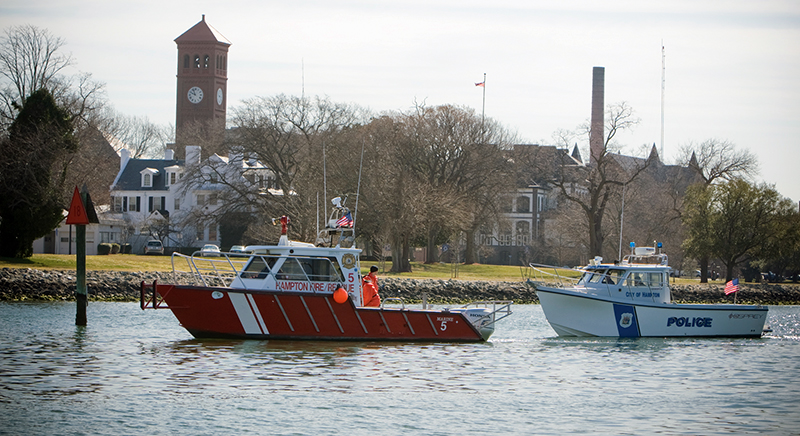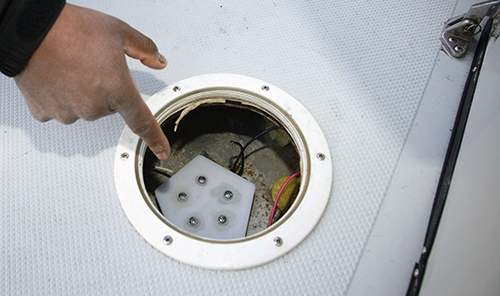
Wireless Fluid-Level Measurement System Equips Boat Owners
Originating Technology/NASA Contribution
While developing a measurement acquisition system to be used to retrofit aging aircraft with vehicle health monitoring capabilities, Langley Research Center’s Dr. Stanley E. Woodard and Bryant D. Taylor, of ATK Space, developed a novel wireless fluid-level measurement system.
Current fluid-level measurement methods, which see widespread application, have significant drawbacks, including limited applicability of any one fluid-level sensor design; necessity for each sensor to be supplied power via a direct electrical connection and have a physical connection to extract a measurement; and need for a data channel and signal conditioning electronics dedicated to each sensor. Use of typical wired systems results in other shortcomings, such as logistics for adding or replacing sensors, weight, and the potential for electrical arcing and wire degradations.
The wireless fluid-level measurement system that Woodard and Taylor developed, however, uses sensors that are simple: passive inductor-capacitor circuits. The system is laid out in seven U.S. and international patents and patents-pending, collectively resulting in an inexpensive and safe wireless fuel measurement system that can be used to measure the volume of any fluid at any orientation. A key safety feature unique to the system is that it allows the sensors to be completely encapsulated so that the fuel level can be measured with neither the fuel nor fuel vapors coming in contact with any electrical components of the system, thus eliminating the potential for combustible fuel vapors being ignited by arcing from damaged electrical components.
Woodard explains, “This technology eliminates many of the causes of the TWA Flight 800 and Swissair Flight 111 accidents. These accidents resulted in the loss of 459 lives. In both cases, damage to a direct electrical line from the aircraft power system to a fuel probe inside a fuel tank containing combustible fuel vapors was a critical link in a chain of events that led to these tragedies.”
The sensor is also not subject to the mechanical failure possible when float and lever-arm systems are used—system sensors are powered by oscillating magnetic fields; once electrically excited, each sensor produces its own magnetic field response, the frequency of which corresponds to the amount of fluid within the sensor’s electric field. The system can be used to measure any fluid in any container, including those on aircraft, cars, boats, trains, trucks, or even the space shuttle and satellites. In addition to the safety features, the system is able to automatically recalibrate for new fuels, a feature that is becoming more attractive as the number of flex-fuel vehicles increases.
One especially key advantage of this technology is that it can be used with any system requiring fluid-level measurement, regardless of the fluid being measured. The sensor design can be modified for measuring the level of any fluid or non-gaseous fluid substance that can be stored in a nonconductive reservoir. The inventors demonstrated this by measuring levels of ammonia, liquid nitrogen, salt water, tap water, transmission fluid, bleach, sugar water, and hydrochloric acid—all elements that would easily destroy most electronics. The system’s ability to take accurate measurements of the level of non-liquids has been tested with powdered sugar and ground corn. Perhaps most importantly, it has been used to measure the levels of a variety of petroleum products, which led to its first commercial application.
Partnership
The NASA technology was of interest to Tidewater Sensors LLC, of Newport News, Virginia, because of its many advantages over conventional fuel management systems, including its ability to provide an accurate measurement of volume while the boat is experiencing any rocking motion due to waves or people moving about on the boat. Like a conventional float gauge, it is quick and easy to install, but unlike the float gauge, this device has no moving parts, is sealed from the elements, and allows the boat owner to use any size or shape tank and still get an accurate reading. The system also introduces no electronics into the tank and has no connections at the sensor that need grounding. These advantages led the company to license the novel fluid-level measurement system from NASA for marine applications.
Product Outcome
The Tidewater Sensors commercial version of the NASA measurement system is available under the name TS1500. The non-moving probe contains both the antenna and the sensor as a single unit that is easily interfaced to any of the standard fuel display gauges used. The TS1500 is a simple, safe, easy-to-operate tool that prevents expensive motor damage and helps prevent boaters from getting stranded due to motor failure.
If the TS1500 detects water, it alerts the operator with both an audible and visual alarm: the machine beeps and the fuel gauge fluctuates rapidly between empty and full. Unlike other water sensors, which require that the water be mixed with the fuel and the boat be run for a few minutes before they will operate, this sensor will alert the operator before he leaves the dock. This means that boat operators can avoid an engine-stopping combination of water and fuel in open waters. The TS1500 sounds the alarm as soon as the engine is turned on, if water is present, or as soon as the sensor touches the water.
The product boasts several other advantages over traditional float systems or capacitor sensors: it is highly accurate; senses water in gas, oil, or diesel; and uses a specially formulated rubber gasket capable of withstanding ethanol, as opposed to typical methods that provide rough measurements of fluid in the tank and use cork or butyl rubber stoppers that corrode when exposed to ethanol, leading to leaks. The TS1500 also provides linear measurements of tank capacity, as opposed to the swinging arm of a non-linear measurement, which leaves the needle indicating full for a longer period of time than may be accurate and then moves quickly toward the “E.”
Tidewater Sensors has already built and field tested prototype sensors. Testing took place on boats ranging from 20 to 32 feet long, operating on coastal waters between Delaware and North Carolina. For some high-profile testing, the sensors were installed on the Hampton City (home to Langley) Fire Division’s 30-foot boat, which patrols all 64 miles of the Hampton area shoreline, and the Hampton City Police boat. Sensors were also installed on a Donzi ZF powerboat owned by John Isley of the nationally syndicated morning radio show, John Boy and Billy’s “The Big Show.” With this high-profile testing, and boasting so many clear benefits, the NASA technology is sure to find wide commercial acceptance.

In addition to giving boat operators a highly accurate reading of fuel levels, this sensor detects water in the bottom of the tank, whether it is mixed with ethanol, gasoline, diesel, or two-stroke oil.

Prototypes of the devices were used on the Hampton, Virginia, fire and police department boats.













